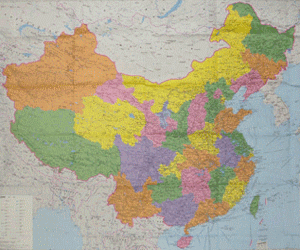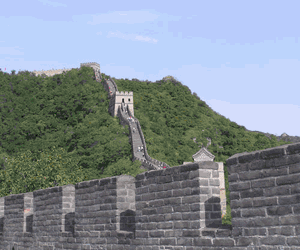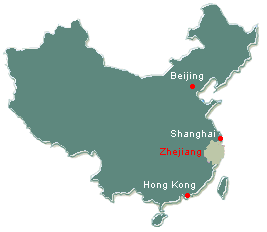|
|
|
Geography of Zhejiang |
Zhejiang Province is situated to the south of Taihu Lake
on the coast of the East China Sea, its coastline
extending over 2,200 kilometers. The Qiantang River
flowing through the Province used to be called the
Zhejiang River, after which the Province was named.
Zhejiang Province covers an area of over 100,000 square
kilometres with a population of
48.98 million (2006),
which mainly comprises the
Han,
She,
Hui,
Manchu,
Miao
and other nationalities.
Hangzhou is the capital of the
Province.
|
|
|
Climate of Zhejiang |
Zhejiang Province has a temperate and humid climate with four
distinctive seasons. The average annual temperature of the Province
ranges from 15°C
to 19°C
(59°F
to 66.2°F)
January, the coldest
month, has an average temperature of 2°C
to 8°C
(35.6°F
to 46.4°F),
while July, the hottest month, has an average temperature of 27C to
30C with an average annual precipitation of 850 - 1700 mm, Zhejiang
Province is one of the fine weathered province of China.
|
|
|
Brief History of Zhejiang |
A Brief History of Zhejiang
Civilization emerged in Zhejiang back in the New Stone Age. The Da
Yu Mausdeum at the foot of Huiji Mountain is said to be the tomb of
Yu, the reputed founded of China’s Xia Dynasty (21th-16th century
B.C.). When China was unified in the Qin Dynasty (221-207 B.C.),
Zhejiang was under the administration of the three prefectures---Huiji,
Zhang and Minzhong. There remains at the food of Baoshi Hill in
Hangzhou a stone relic showing that the first emperor of the Qin
Dyansty paid an inspection tour to Zhejiang. During the tenth
century, Qian Liu, a former governor of Tang Dynasty (618—907 A.D.)
established the State of Wuyue in Zhejiang. During the 12th century,
the Southern Song Dynasty moved its capital to Hangzhou in face of
external aggression. The Province became what it is today since the
Qing Dynasty.
|
|
|
Zhejiang Local Products |
Zhejiang Province is an important silk producing region in China.
Known as the “home of silk” in China, the Province produces over
1,000 different varieties of satin, which has own the fame of
“flower of oriental art”. The West Lake Longjing tea with its bird’s
tongue shaped leaves is famous for its jade green colour, pleasant
fragrance and refreshing taste. One of the eight leading liquors in
China, Shaoxing wine is characteristic of its glistening sweet smell
and mellow taste. Jinhua Ham, famed in colour, is unique in its
fragrant and mellow flavour, tender and delicious taste. The
Province is also famous for its Huangyan tangerine and West Lake
water shield. Zhejiang offers a great variety of arts and
handicrafts produce, such as the Hangzhou fan, West Lake silk
parasols, Shengxian bamboo articles, Qingtian stone carving,
Dongyang wood carving, Wunzhou bowl sculpture, Ningbo wood ware
inlaid with bones, Langquan swords, Xiaoshan lace, Longquan celadon
ware, Zhang Xiaoquan scissors, etc.
|
|
|
Zhejiang Local Cuisine |
Zhejiang cuisine is one of the eight famous culinary schools in
China, consisting mainly of the specialities of Hangzhou, Ningbo and
Shaoxing. Hangzhou cuisine is characterized by its elaborate
preparation and varying techniques of cooking, such as sauté,
stewing, and stir and deep fired. Hangzhou food tastes fresh and
crisp, varying with the change of season. Ningbo food is a bit salty
but delicious. Specializing in steamed, roasted and braised seafood,
Ningbo cuisine is particular in retaining the original freshness,
tenderness and softness. Shaoxing cuisine offers fresh aquatic food
and poultry that has a special rural flavour, sweet in smell, soft
and glutinous in taste, thick in gravy and strong in season. Famous
Hangzhou specialties are: West Lake fish in vinegar sauce, fired
shrimps with longjing tea, Songsao fish soup, Dongpo pork, beggar’s
chicken and consommé of West Lake water shield.
|
|
|
Places of Interest and Tourist Attractions: Zhejiang |
|
Tourist Attractions of Zhejiang Province
The cities of Hangzhou, Shaoxing, Ningbo, Wenzhou and Mogan Mountain
of Deqing Country, Yandang Mountain of Leqing Country, Tiantong
Temple of Yinxian Country and Yaolin Cavern of Tonglu Country are
open to tourists. Hangzhou and Shaoxing are leading Chinese cities
of historical and cultural fame.
The West Lake of Hangzhou, Fuchun
River, Xin’an River, Yandang Mountain and Putuo Mountain are the
first group of major scenic designated by the state. Hangzhou is the
tourists centre of Zhejiang Province, with the West Lake crowning
the western part of the city like a bright pearl. Scattered in the
hills around the lake are streams, springs, pounds and creeks
alternated with caverns, valleys, peaks and rockeries.
Coupled with
the decoration of pagodas, temples, steles and rock carvings, all
this has added to the lustre and attractiveness of the West Lake.
The West Lake presents a panorama of enchanting scenes with change
of season during different times of the day and under different
weather conditions.
After touring Hangzhou, known as the “paradise
on the earth”, one may visit the ancient river town of Shaoxing or
enjoy the ancient and serene environment at the Guoqing Temple on
Tiantai Mountain. Yandang Mountain is reputed for its gorgeous
scenery with hills and waters; Mogan Mountain is a famous summer
resort in China; renowned for its Buddhist temples, Putou Mountain
is known as “Buddhist Kingdom of the sea”. The islet on the Oujiang
River to the north of Wenzhou City has the fame of being a fairyland
on the Oujiang River.
Tianyi Pavilion in Ningbo is one of the oldest
libraries in China. Yaolin Cavern of Tonglu Country presents an
infinite variety of fantastic scenes rarely found elsewhere. All
these places of historical interest and scenic spot around Hangzhou
hold out great attractions to tourists, both Chinese and foreign.
The major scenic spots are the West Lake, Mt. Putuo, Mt.
Tianmu,
Qiandao Lake, Qiantang River, Tiantong Temple, Baogou
Temple, the former Residence of Lu Xun.
West
Lake
Hangzhou's fame rests mainly with the picturesque West Lake,
so named because it is located in its western fringe. Covering about
four square miles,
West Lake is surrounded on three sides by rolling wood hills. At the
center are three isles--Lesser Yingzhou, Mid-lake Pavilion and Ruangong
Isle. Solitary Hill stands by itself on the northern lakeshore. It can
be reached from the city by Bai Causeway, with Su Causeway bisects the
lake from north to south. The blue, often rippling, water is dotted with
elegant stone bridges
and charming pavilions.
Qiantangjiang
Tidal Bore
If you are visiting in September during the autumn equinox, you
may be able to see one of the most unusual sights
in the world. A tidal bore gathers momentum in the Gulf of Hangzhou,
surges into the mouth of the Qiangtang River, and races up the river, at
a height of up to 30 ft. and a speed of more than 15m.p.h. In ancient
times, governors of Hangzhou used to have arrows fired at the waves in
an attempt to quell their destructive forces.
Nowadays more effective methods are used.
Linglin
Temple
It is believed that the temple was first established in 336 A.D.
by a monk known as Hui Li. It was destroyed on a number of occasions,
the last time during the Taiping Rebellion, and the latest rebuilding
was in the early part of the
20th century. It
was then restored
in 1956.
The temple sits
at the foot of the Northern Peak in a wooded area, with
a stream running in
front of it. Some of the trees in front are believed to be more
than 1,000 years old.
The foremost temple
houses a laughing Buddha carved in camphor wood and covered in gold with
a carved gilt figure standing behind as a guard. Both figures are set
under a two-eaves wooden canopy decorated in red and gold. Ornate lamps
hang on either side.
|
|
|
Zhejiang
Related Article and Report Links |
|
Hangzhou: Paradise on
Earth
HANGZHOU, known as "paradise on earth," has
a humid climate, fresh air, a clean,
well-ordered environment, and the West Lake as
its back garden. The land around Hangzhou City
is one of "fish and rice" as well as a
production base for silk. Each person
encountered on its streets radiates contentment.
An increasing number of people are purchasing
villas in the area, and real estate prices have
consequently increased.
Hangzhou is a famous
tourist city. Although not big, it has a concentration of more than
40 scenic spots, which would take at least a week to visit. The
6-square-kilometer West Lake is the pride of this provincial capital
city, and most sites of interest are around it. Unlike the man-made
lakes of other cities, where earth is dug and piled up to make
hills, the West Lake is natural, and its sights are delightful, no
matter what the season. Scholars and poets have left a legacy of
rhapsodic poetry and prose after visits to the lake, and some
settled, or stayed on to live a hermit's life here. There are so
many scenic spots around the West Lake that the view changes at
every step. It was once said that its scenery is poetic, picturesque
and ethereal. A picture taken from any angle resembles a beautiful
landscape painting.
The people of Hangzhou
regard the West Lake as an important facet of their daily life. It
is a place where they eat their meals, drink tea, and generally
enjoy leisure time, often taking a stroll along its shores each
evening before going to bed. The hotels, restaurants and teahouses
around the lake all do a brisk trade. Locals take great pleasure in
going on rambles through the beautiful scenery, and can be seen in
threes and fours taking a walk along the Bai and Su Causeways at all
times. On a fine day, some might ask for time off from work in order
to relax by the lakeshore, and at weekends whole families go on
outings, so each scenic spot is thronged with visitors. People sit
on carpet-like lawns, and enjoy the spring sunshine as they
replenish their energy with the food and drink they have brought
from home. They chat, laugh and frolic against a background of
beautiful flowers, and when sleepy, take a nap.
Hangzhou is also famous
for its beautiful women, who, in addition to being good looking, are
also softly spoken. The women of Hangzhou are elegant and graceful.
They like to have their picture taken, sitting or lying on a lawn,
leaning against a tree trunk, or beside a branch full of peach
blossoms. Beforehand, they have their hair dressed, and wear their
holiday best, and sometimes borrow a parasol from a passer-by to
make an even prettier picture.
Along with such
beautiful scenery and places of interest, Hangzhou has many romantic
tales. Classical stories include legends about Su Xiaoxiao, a
well-known courtesan -- a Chinese Dame au Camellias. Su Xiaoxiao was
beautiful and versatile. Once while sightseeing, she met a young man
from a noble family. They fell in love at first sight. A few days
later, the young man went home and never returned. In the end, the
19-year-old Xiaoxiao died of a fatal disease. There are many poems
dedicated to her, and there is a monument on the Bai Causeway
commemorating her.
Another romantic tale is
about the love between a young man named Xu Xian and the "white
snake" (an immortal, whose earthly form was of a beautiful woman,
but who also took the shape of a white snake if she drank wine).
Their love was not tolerated by society, and finally the white snake
was imprisoned under the Leifeng Tower, and Xu Xian's family
fragmented.
Modern Hangzhou
inhabitants are very romantic, and the West Lake is now the place
where young people go courting. At nightfall pairs of lovers can be
seen all along the lakeshore, as on the Shanghai Bund.
The romantic nature of
Hangzhou inhabitants has nurtured the quality of local artists.
Hangzhou has produced numerous scholars and men of letters, and the
city is permeated with an artistic atmosphere. Every building is
exquisite, especially those around the West Lake, and the city brims
with nostalgia. In parks such as Taiziwan and Gushan, international
modern sculpture exhibitions are often held. The natural landscape
makes a perfect background for sculpture, which, in turn, adds
significance to the whole environment. On Nanshan Road, in the city
proper, now lined with galleries, teahouses and bars, is a fine arts
academy, whose origins go back to the 1930s, when a group of artists
returned from Europe and founded China's first fine arts school.
These artists introduced Western painting techniques to China for
the first time, and were the first in Chinese history to paint a
nude model. They brought about a revolution in the history of fine
arts. Many important figures in the history of Chinese painting
graduated from this school.
During the Southern Song
Dynasty (1127-1279) Hangzhou was the world's most prosperous city,
and the Hangzhou residents' current tradition of leisure originates
from that wealthy era. In ancient times, tea drinking was an elegant
and refined pursuit, but one which called for certain prerequisites.
First, there had to be fine weather and beautiful scenery. Second,
the water, tea, and tea set had to be of the finest quality. Today,
tea drinking is less formal than in former times, and normally
accompanies a meal. There are many restaurants serving both meals
and tea around the West Lake. Although their decor is still in the
traditional style, and traditional music plays in the background,
the noise of cutlery and clinking china in these restaurants
destroys the tranquil mood essential for tea drinking in the
original manner. In recent years, more and more cafes have opened,
and seem likely to replace the old teahouses. These cafes, with
their comfortable furniture, luxuriant plants, dim lights, and
relaxing music daily attract more and more white-collar custom.
Hangzhou is also famous
for its culinary arts. Dishes feature originally flavored sauces,
that are not too oily, and presentation so beautiful as to equal the
Hangzhou landscape. There are more than 40 famous Hangzhou dishes,
including West Lake Sour Fish, Beggar's Chicken, Fish head and
Beancurd, Dongpo Pork, Shrimp Meat with Dragon Well Tea, West Lake
Water Shield Soup, and Sister Song's Fish Soup. Among them, there
are five famous dishes that are a must for visitors: Dongpo Pork is
named after Su Dongpo, a famous man of letters of the Song Dynasty,
and is a little fatty, but not oily. West Lake Sour Fish features
tender fish meat with sweet and sour sauce. Shrimp meat with Dragon
Well Tea was created by chance. In ancient times, while cooking
shrimp meat a chef made the mistake of adding dragon well tea to the
dish as a condiment, but the emperor nonetheless enjoyed it, and the
dish became famous. Beggar's Chicken is tasty and tender, with a
fragrance of lotus leaves. Sister Song's Fish Soup is piquant and
spicy. To try these famous dishes, tourists go to time-honored
restaurants. Louwailou Restaurant is on the north bank of the West
Lake, and famous for local dishes, but is relatively expensive. The
Zhiweiguan Restaurant is well known for its exquisitely prepared
snacks. Steamed dumplings, wonton soup, and fried sweetmeats are
local specialties, and not expensive. At lunch and dinner, this
spacious dining hall is packed to capacity.
Hangzhou inhabitants are
not, however, completely poetic, being as smart and astute as the
businesspeople of Shanghai. To cater to the demands of foreign
tourists, Wushan Road is lined with vendor's stalls, selling silk,
paintings and calligraphy, antiques, and antique furniture. There
are genuine and fake antiques, and only experts can tell the
difference. Prices vary, and tourists need to bargain. A silk scarf
on one stall may sell for ten yuan, but on another it may be bought
for four yuan. It must be remembered that the seller is always
smarter than the buyer. When bargaining with Hangzhou vendors, local
buyers usually offer a price slightly higher than half that quoted.
When buying silk, visitors are recommended to go to Silk City. This
is where a concentration of sales outlets dealing in foreign trade
for Hangzhou's famous silk plants may be found. Although prices are
slightly higher here, the goods are of a better and more consistent
quality.
(By ChinaToday Magazine staff reporter ZHANG XUEYING,
June 2002) |
|
| |
|
|
|
|
Zhejiang Useful Links and Sites |
|
|
|
|
Major Citis
in Zhejiang (City Official Sites) |
|
Zhejiang Cities' Government Site:
City and Town Information:
|
|
|
Tourist
Attractions in Zhejianng Province |
|
|
|
|
|
|
ADVERTISEMENT
 |
|
|
ADVERTISEMENT
 |
|
|
ADVERTISEMENT
 |
|
|






